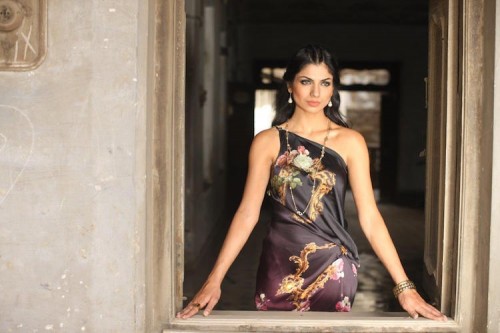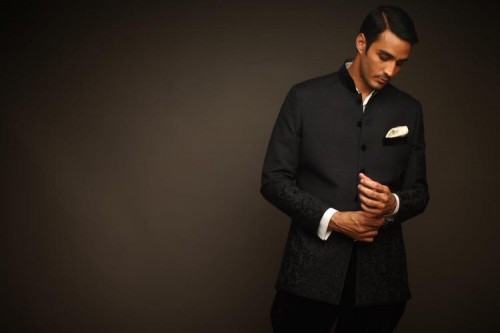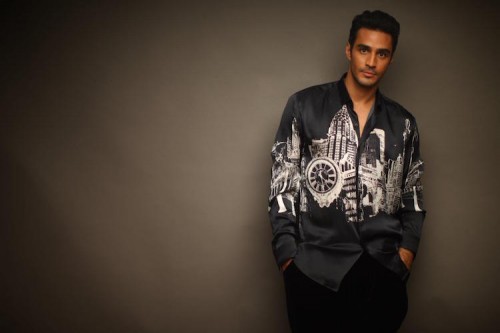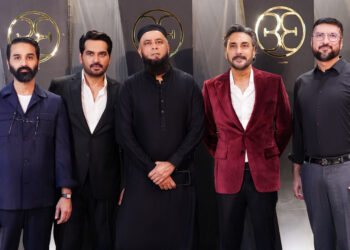“Fashion is not an easy ride for anyone,” says Deepak Perwani who is not just a name but a legacy for the Pakistani Fashion Industry, “I’ve had an amazing life and I’m not at all complaining.”
At only 20 years of age, Deepak stepped into a career in fashion that turned his life for the better. “I didn’t know who was going to walk into my room. There were celebrities, ministers, prime ministers, and I was just like, dude! I’m only 20 years old.” But, three MTV awards, two HUM TV awards and several international acclaims later, the same Deepak Perwani sits down with Team SiddySays and recounts his 20 glorious years in fashion.
“I won’t say that I didn’t like the attention. In fact, I liked the attention back then and I love the attention right now but 20 years down the line have definitely settled me down!”
1. 20 long and illustrious years, Deepak. How does it feel?
Ah, it feels good, it feels like I’ve achieved a lot. There’s a phenomenal sense of peace and more confidence. I don’t worry about a lot of things like I used to worry about. I’m still a control freak, like a tiger. But I’m much more at ease with myself. I feel honored and have a lot of gratitude that I was a part of something that 10 years ago was considered a cottage industry. And within these 10 years, with the regulation of fashion weeks, retails, brands, export garment factories like Gul-Ahmed and Alkaram and formation of fashion councils, it has become this huge commodity in Pakistan.
2. Did you always envision yourself to be a fashion designer?
Oh no, not at all, I actually wanted to be a fashion merchandiser and an actor. I didn’t want to be a fashion designer and it wasn’t something that crossed my mind. I was in New York, and I came here for a bit and started working for my uncle’s export house. I used to help him out with designs and everything. And just for pocket money, I started designing. It was never supposed to be a full-fledged thing, I was always supposed to go back to New York and continue my studies which I never did!
3. And what about your family? Have they been supportive?
My mother has always been very supportive. She’s a cool chic. Actually, both of my parents have been very supportive. They gave me a store space for my 21st birthday and gave me money to decorate it also!
4. If you could pick and choose, then what would be the proudest moment of your life?
For me, Milan was a really proud moment. This is when one of our images got selected by Assouline Fashion Books for a coffee table book on Frida Khalo that they are printing; that was a proud moment. Another would be when Javed Akhtar was receiving an award from the President of India, and Shabana Azmi called and told me “Beta, Javed is wearing your sherwani”. I think that was a proud moment. Also, when the European council selected me as the 6th Most Innovative Design House in the World, I mean, coming from a developing country; it was a moment.
All in all, I think a proud moment is when you receive an accolade for it. For the past 20 years of my career, there have been phenomenal and amazing times enough that I don’t even remember half of them. But I still remember; in Milan we got a standing ovation, and when I took the same collection to British High Commission in London, Maheen and I, we sold out in 12 minutes! I mean, no one sells out in 12 minutes! When we pulled out the first fashion week, despite having no money, I think that was a proud moment.For me, anything you do with friends and peers, collectively as a whole will always be a proud moment. Like that 8 pages of fashion week coverage by British Vogue, that again was a proud moment for the whole country. Showing Pakistan’s face in India, Pakistan’s face abroad, it has truly been a great journey!
5. Recently you showcased your collection at Pakistan fashion festival, North America and at Pakistan Fashion Week, Doha. How different is the international market from the local one you’re accustomed to cater to?
All markets are different. But primarily as a South Asian designer, I tend to cover the markets in England, America, Dubai, India, Pakistan, and wherever desis live. When you look into the local market and compare; in Karachi people want less embroidery but in Lahore they want more. Similarly, in Hyderabad, women are more interested in 3-piece suits and not just kurta and dupatta.
Similarly, North America, and Doha have very different markets, but primarily, the requirement remains the same that everyone wants eastern wear or fusion eastern wear or bridal wear. So, you see, the silhouettes themselves don’t change as such but the demand for what the people are looking for changes drastically. Doha has a good upcoming market. The North American trip was fantastic as well!
6. How’s the work like at a Deepak Perwani factory?
We generally tend to show a western wear collection at Spring/summer fashion week, and more of an eastern wear collection at PBCW. And also, a lot of times we convert the western wear into kurta and kurtis to put up at our flagship store. See, we work with a timeline. Once our S/S dolce vita collection is out, we make kurtis, kurtas, dupattas, tunics out of the digital print cloth and send it to the store. Then we make 12 pieces of the same western wear and send it to stores for anyone who wants to buy the western piece and wear it as off the ramp. Then we take the sample dolce vita collection and showcase it at international forums. 
7. What do you say in regard to the claim that the Pakistani designers aren’t ready to cater to their international demands?
I’ve said so myself, plenty of times, 3 things come into play: timeline, finishing, and consistency of pattern and design that Pakistani designers lack. Many designers who’re doing prêt and ready-to-wear for stores have gotten the grip of that but let me assure you, go to any major designer take 3 garments off the rack and measure them. There will be a certain level of discrepancy in size. To say the least, when it comes to the export order, they don’t work in inches, they work in centimeters. The local designers, who work best at order, aren’t ready to cater to the mass export demands. Would you cater to the orders you’ve brought in with you from abroad, cater to the local made-to-order attires or work on the new collection that’s due in 3 months for the next fashion week? They’re pretty much happy with their own domestic local market they don’t have the time or the patience to add more load to their work-timelines.
8. A global recognition isn’t really a new thing for a designer like you, but how did it feel like to receive the 6th Most Innovative Design House in the World award by the International Bulgarian Fashion Council?
First off I’ve been telling everyone that it’s not Bulgarian, it’s the Camera Moda Council Award. It felt fantastic. Bulgaria was an amazing trip, they did the show at the National History Museum, and not a lot of people get the access to that location. I had a great time. And now we want to do shows at Tokyo, Vancouver and Kenya. I chose these three locations because I haven’t been to these yet, and one of the best part of my job is that work and pleasure go hand in hand.
9. What’s in store for your 20 year completion celebration?
There’s a book coming up! We’ve already been featured in 2-3 international coffee books: we made it to The Trends Book 2010-2011, The Embroidery Book and the Atlas of Fashion Designers and in the Frieda Khalo coffee book. We are also coming out with our own coffee table book. But I’ve planned to come out with three to four books over the course of time because I feel one is not enough to cater to everything. So our first book will cover the first 10 years, from 1994-2004 and talk about what fashion was like back then, how conservative was men’s wear, what we exactly did, etc. The book will come out, very soon, and I will throw a party which I’m trying to avoid for now! Haha.
A lot of other stuff is also in the pipeline. I’m going to go to Kenya next month for the Kenya Fashion Week, mainly because I haven’t been to Kenya and I’m really looking forward to exploring that place. Then I’ve taken up an assignment in Manchester, after which I’ll be going over to Tharparkar for a four-day workshop with the women about patterns and ralli making etc. We’re also in the middle of talks with the government about opening up a new school, PFDC Karachi. The government needs to allocate the funds for the school, which we’re pushing them on for.
10. You’re not just the creative head of the brand but also business savvy enough to solely run your own retail- business, how did you do it all?
[Points towards his head] Haven’t you seen this? Haha. I’m still the designer head because I feel as soon as the designer lets go and doesn’t invest himself in the inspiration process the design houses tend to lose their strength. So still, all inspiration and designs for the brand are directed by me. We also have a design team that works along with me. As far as being the business head is concerned, we do have a general manager who controls and looks over the factory and the store. But when it comes to finances, I’m still the person who signs off most of the cheques etc.
11. Talking about your collections for a bit. We saw that “Everything But The Girl” brought back your conventional all cuts and prints. What was the idea behind bringing the quintessential-Deepak Perwani-quirk back in fashion?
If you look at my collection closely, there’s a red tshirt with a big roster that was done in 1996, there was another scarf with chains on it which was done in 1998. ‘Everything But The Girl’ was a collection that I basically wanted to do back then, but this was a collection that was a bit too eccentric and too fashion forward, and for the right word to put it, it was basically too metrosexual for Pakistan at that time. It was just too avant-garde and racy for its time. So I shelved it.
My friends who knew how eccentric and fashion forward I have always been, were sitting in the front row at that time, laughing and saying that he waited 14 years to showcase this collection. That collection was a complete thrill. The kind that got me started in this business of fashion in the first place.
12. You’re now known as a designer who has played it safe. No notorious editorials or controversy whatsoever. How have you managed to prevent yourself from falling into trap that almost every fashion designer does?
Actually no, I haven’t. The first 10 years of my career I was completely wacked out. I wouldn’t really say safer, but I’d say we started doing more beautiful, wearable collections now. I told my team that two decades have passed, we don’t need to prove ourselves to anyone, anymore. We should just do what we do. Chanel, Valentino and no major international design house tries to prove itself, we shouldn’t either. The shock value, I’d say is now for the younger generation and younger designers. I don’t even like to put the shirtless man on the ramp. Those days are simply gone now. Back in the day, we did all sorts of crazy. Now I think of shock value as a passé, that’s so in the 90s, I find it in the bad taste.
13. What’s one piece of advice you want to give to young and aspiring designers?
Do not think that if your work is good enough, it will not shine. It will shine. You do not need people or contacts for it.
14. What are your thoughts on changing the nature of Pakistani fashion industry?
Kick ass, dynamic, out there, confident, stylish, sexy, elegant and beautiful. Pakistani designers are super talented if only they did not have to go through all the struggles they do to produce their collections. The light, gas, water, strikes, PR stuff and the so-called journalists who sit in front rows and do not know how to write – if this all wasn’t there then they’d produce even better designs. 10 years ago, Maheen, Shamaeel and I along with the rest just jumped onto this bandwagon because we felt at that time we needed to empower young talent and the women in Sindh and Tharparkar, with whom we developed the cultural designing philosophy and ralli, lace and everything. I believe 20 years down the line, we’re still trend setters, not followers. Our thing will always be different from everyone else.
RAPID FIRE QUESTIONS
iPhone or android
iPhone
Twitter or Instagram
Both are confusing!
Karachi or Lahore
I love both cities. Karachi I live in, and Lahore is what I find beautiful. It’s such a pretty city.
Couture or prêt
Both
Who’s your style icon
Grace Kelly
What’s the best thing about working in the fashion industry
That the fabric is a blind canvas and you can write anything that you want to
What’s the worst thing?
There’s too much inspiration and not enough originality.
If you had to spend unlimited money at one store, anywhere around the world, where would you?
John Varvatos
What’s in your playlist right now?
Want to want me by Jason Derulo
What do you think the biggest trend of 2015 will be
Lace, lace and more lace
What is the most outrageous thing you have ever bought for yourself
I wanted to buy these red velvet Louboutins for myself, but I couldn’t find it in my size and I was dying to get them!
What is one trend that you think has been done to death?
Ah, if only Pakistani women would stop wearing tunics.






